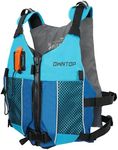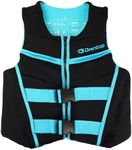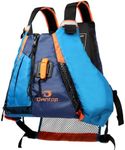Buying Guide for the Best Life Jackets
Choosing the right life jacket is essential for your safety and comfort during water activities. The best life jacket for you will depend on where and how you plan to use it, your swimming ability, and your body type. It's important to understand the key features and specifications so you can make an informed decision that keeps you safe and comfortable on the water.Type/ClassificationLife jackets are categorized into different types based on their intended use and the level of safety they provide. These types range from those designed for offshore, rough waters to those meant for calm, inland waters. The main types include those that turn an unconscious person face-up, those for general boating, and those for specialized activities like kayaking. To choose the right type, think about where you'll be using the life jacket most often—open sea, lakes, or rivers—and pick one that matches those conditions for maximum safety.
BuoyancyBuoyancy refers to how much weight the life jacket can keep afloat in the water. It's measured in units like pounds or newtons. Higher buoyancy means more flotation, which is important for rough waters or for people who are not strong swimmers. For calm waters or for those who are confident swimmers, a lower buoyancy may be sufficient and more comfortable. Consider your swimming ability and the water conditions to decide how much buoyancy you need.
Fit and SizeA life jacket must fit properly to work effectively. Fit and size are determined by your chest measurement and weight. A jacket that's too loose can slip off, while one that's too tight can be uncomfortable and restrict movement. Most life jackets come with adjustable straps to help you get a snug fit. To pick the right size, measure your chest and check the manufacturer's sizing chart, and always try the jacket on if possible to ensure it feels secure but not restrictive.
Material and ComfortLife jackets are made from different materials, such as foam or inflatable chambers, and the outer fabric can vary in softness and durability. Foam jackets are always ready to use, while inflatable ones are lighter and less bulky but require activation. Comfort features like mesh panels, soft linings, and ventilation can make a big difference, especially if you'll be wearing the jacket for long periods. Think about how long you'll wear it and what activities you'll do to decide which material and comfort features are best for you.
VisibilityVisibility refers to how easily you can be seen in the water, which is crucial in emergencies. Bright colors and reflective strips help rescuers spot you quickly. If you'll be in busy or open waters, or if you want extra safety, choose a life jacket with high-visibility colors and reflective elements. This is especially important for children and for use in low-light conditions.
Special FeaturesSome life jackets come with extra features like pockets, whistles, harnesses, or attachment points for gear. These can be useful for specific activities like fishing, sailing, or kayaking. Think about what you'll be doing on the water and whether you need any of these additional features to make your experience safer or more convenient.



















